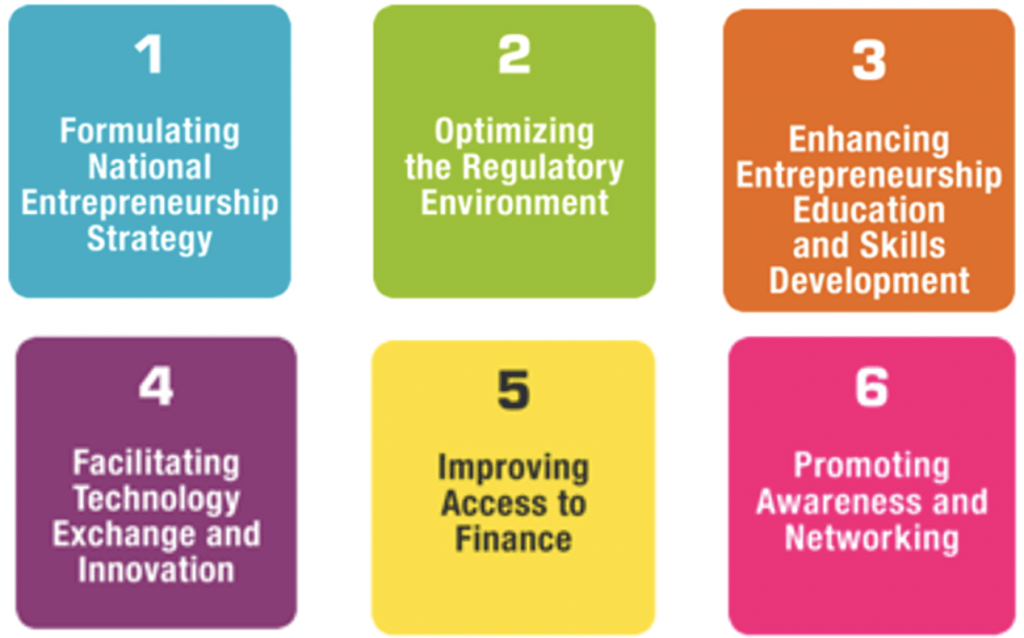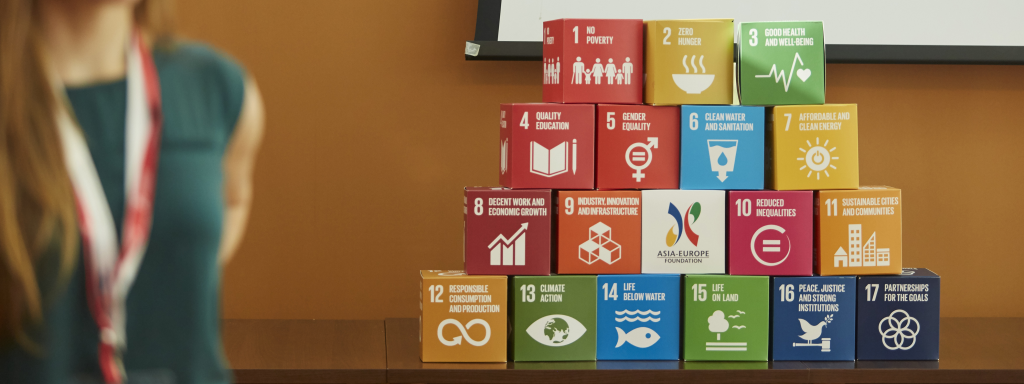Sustainable Innovation
Whether you are an innovator or an investor, young entrepreneurship plays an important role for everyone. The past decades have seen an increase in industrial and technological advancement. As such, the need for sustainable innovation has also escalated. Although barriers such as the recent COVID-19 pandemic have halted such growth, there is a silver lining. Increased unemployment rates have seen a rise in entrepreneurship in millennial youth (Maritz, et al., 2020). It is undeniable that the thoughts and behaviour of millennials are different to previous generations. This means that it is even more important to align with new values, which will help encourage sustainable innovation in young entrepreneurs.
Key Components of UNCTAD Entrepreneurship Policy Framework
As is stated within the United Nations sustainable development goals, (UN SDGs), sustainable innovation includes three aspects:
- Economic prosperity
- Social equity
- Environmental Protection
The General Assembly identifies the role of entrepreneurship as a key trigger for development. It assists in identifying economic, social, and environmental challenges as well as promoting sustainable development. This was supported by the entrepreneurship policy framework and implementation guidance developed within the United Nation’s Conference on Trade and Development. Under the framework, the committee explores six key components as summarised below.

1. Formulating a National Entrepreneurship Strategy
The opportunities for young entrepreneurship are not equal among different countries. Therefore, it is essential to determine the current status, challenges and barriers to each individual. Support must then be made available to overcome these challenges. Matching innovation strategies with a country’s development produces the most effective pathway toward long-term sustainability.
2. Optimising the Regulatory Environment
One of the major setbacks for most young entrepreneurs is the understanding of government policies and adherence to laws and regulations. This complex process can be overcome by providing special support to new start-ups, which can majorly encourage early-stage entrepreneurship. This will ultimately assist small innovative businesses to thrive in the long term.
3. Enhancing entrepreneurship, education, and skills development
Alongside technological knowledge, improving essential softs skills should be focused on. This includes planning and organisation, business and financial intelligence as well as management skills. In addition, inherent traits such as resilience, persistence, networking and confidence should be prioritised. Incorporation of such skills can thus be gained through real-world scenarios, via teamwork, risk-taking, and decision making. Not only can these aspects be learned within traditional education channels, but also through traineeships and apprenticeships. Such instances work to build the capacity and confidence of young entrepreneurs.
4. Facilitating in technology exchange and innovation
Innovation and technology are two interdependent processes. While technology provides tools to aid innovation, innovation simultaneously introduces novel technologies in return. This sets up a strong foundation for young entrepreneurship. However, it is important to remember that, unlike first world nations, the use of technology in developing countries is still restricted. Such a dynamic can be alleviated through public-private partnerships and the sharing of expertise and resources between countries. This networking can facilitate the identification of cost-related issues, as well as provide investment opportunities for sustainable, green innovation.
5. Improving access to finances
The financial benefits available for young entrepreneurs primarily depending on a country’s economy. This places low socio-economic nations at a disadvantage. It is therefore essential to identify specific financial needs, current plans, and necessary development of credit systems. Highlighting the importance of sustainable innovation among young entrepreneurs in developing countries will attract more venture capital and angel investors. Financial partnerships between public-private sectors to provide necessary training and financial intelligence can create significant improvements in promoting young entrepreneurship, and thus to an overall country’s economy.
6. Promoting awareness and networking
In order to develop self-driven entrepreneurial culture, taking policy-making measures is encouraged. These include but are not limited to:
- Launching awareness programmes and training workshops which highlight the values entrepreneurs can offer to sustainability.
- Completing work at a national, as well as local level.
- Organising networking events and career fairs.
- Rewarding success, and celebrating potential role models.
Young communities are attracted to entrepreneurship through the availability of knowledge, support, financial benefits and overall professional satisfaction. Such behaviours will champion these positives and ultimately encourage young minds.
Empretec Global Summit

As a part of the UNCTAD framework, the annual ‘Empretec’ Global summit‘ was held on 20th April 2021 for the 7th consecutive year, under the theme, ‘Post-COVID-19 Resurgence of the MSME (micro-, small- and medium-sized enterprises) sector’. The associated training workshop aimed at fostering self-confidence and motivation in innovators and green entrepreneurs, and reach set Sustainable Development Goals. The networking included knowledge sharing on start-ups and revenue generation, and opening funding opportunities among its centres in 40 countries. A major component of Empretec is the ‘Empretec Women in Business Awards’ which seeks to reach gender equality within the innovation community.
Young Entrepreneurship and UN Sustainable Development Goals

The United Nations SDG9 promotes industry, innovation, and infrastructure. Innovation provides the opportunity for young entrepreneurs to think creatively about sustainable solutions to the prevailing issues. Jackson, in his 2020 publication, explains the adaptation of the ‘theory of creative destruction’ proposed by Joseph Schumpeter in 1942 to achieve UN SDGs. There are a number of main categories that he focuses on throughout the text.
SDG1 – No poverty
Even though there has been a decrease in extreme poverty rates within developing countries, the overall rate of decline is not sufficient to achieve long term sustainability. There are still many regions currently living in poverty, and entrepreneurs should seek to address the social, economic, and environmental issues which surround them. This will ensure that innovative technology reaches out to the communities in need, and solves the issues of efficiency and productivity.
SDG2 – Zero hunger
While reducing poverty, limiting starvation is a role of innovative entrepreneurs. Utilising biotechnology to improve high nutrient crops, increase yield and establish drought resistance through genetic modification, is one such approach that is under research (Hirschi, 2020) for long term sustainability.
SDG3 – Good health and wellbeing
Innovation can be utilised to improve existing medical technologies. This enables the identification of incurable diseases and the crafting of cost-effective medical technologies. This improved reachability ultimately aids sustainability both in the developed and developing world. Furthermore, there is a high demand for improved infrastructure to support local drug manufacturing and synthesis among entrepreneurs. This would make possible the creation of cost-effective essential drugs in low-and-middle-income country settings (Cooray, et al, 2018).
SDG4 – Quality education, SDG5 – Gender equality and equity, SDG8 – Decent work and economic growth
Jackson and Schumpeter suggest that an improvement to education systems would fit the future creative demands within society.
To highlight the importance of initiating green innovation at a young age, mass entrepreneurship and innovation programmes have been introduced in schools. One such example is China College Students’ ‘internet plus’ innovation and entrepreneurship competition (CSIPC). Under the programme, college students are encouraged to initiate start-ups focusing on sustainable social and economic development, and addressing China’s environmental issues. Encouraging all genders to partake in such innovative entrepreneurship without discrimination is heavily suggested.
SDG7 – Affordable and clean energy, SDG9 – Industry, innovation and infrastructure
A critical measure in sustainable innovation is the development of sustainable energy sources. The subsequent improvement of cost efficiency enables the regular consumption and utilisation of green energy systems.
SDG10 – Reduced inequalities (within and among countries)
The authors emphasise that entrepreneurs should aim to reduce inequalities while innovating smart technologies. This is identified as an easy target for corruption over sustainability during wealth creation and profit-making through investments.
SDG11 – Sustainable cities and communities
Technological innovations related to artificial intelligence (AI), the internet of things (IoT), and machine learning embedded facilities can be key factors in the development of sustainable cities.
SDG16 – Peace, justice and strong institutions, SDG 17 – Partnerships for the goals
Together with the development of sustainable cities and communities, it is essential to establish clear policies and regulations. This will ensure that technologies can be used at their highest efficiency, without creating economic, social or environmental adversity.
Are Young Entrepreneurs the Key to a Sustainable Future?

In supporting young entrepreneurs, Lüdeke-Freund (2019) proposes a business model for sustainable innovation. The ‘agency perspective’ discusses the modification of existing business models and strategies to align with sustainable innovation. The ‘systems perspective’ analyses how the developing business models and entities align with sustainable innovation. The ultimate outcome gives value to stakeholders, while still contributing to economic, social and environmental prosperity.
New technologies are emerging rapidly to address the issues which are rising globally. Environmental problems such as climate change and carbon emission are being addressed through promoting affordable solar systems, or the introduction of electric cars by major automobile manufacturers such as Tesla, and Ford. Management of scarce resources – like water– is done through the development of new water management systems and sustainable water purification technologies. Addressing global health through cutting edge medical technologies such as brain-computer interface, or robotic surgery continues to develop.
Technology is frequent among the young entrepreneurial community. However, it is vital to shift the mindset of individuals and encourage sustainable, green innovation through existing technology. Starting at a young age, with proper guidance and mentoring, millennial viewpoints and mindsets can become a solution to achieving long-term sustainability.
The team at THRIVE Project has been working with Professor Florian Ludeke-Freund over the last few years to develop a method that uses machine learning to identify which strategies, or business models for sustainable innovation, are most sustainable. Details of this research are available on the resources page. To learn more about Sustainability visit the THRIVE Project. Let us know your thoughts in the comments below.























